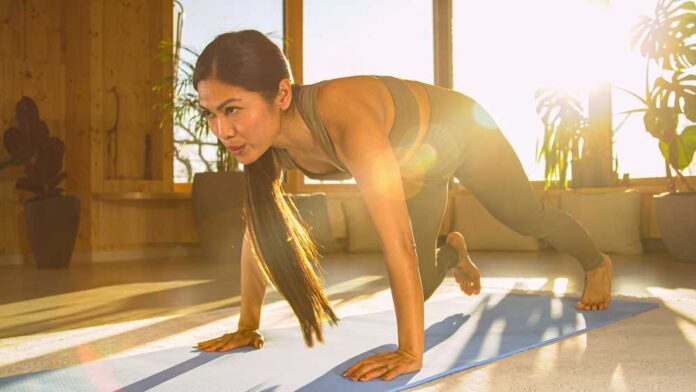
Ab exercises are often associated with the goal of achieving a six-pack, but the benefits of working out your lower abs go far beyond just aesthetics.
Strong lower abs play a crucial role in supporting your core, which in turn helps improve your posture, increase flexibility, relieve back pain, improve digestion, and prevent injuries.
Here are 5 lower ab workouts you can include in your weekly routine:
Reverse Crunches
In a normal crunch, you bring your upper body towards your legs. This exercise is the opposite of that, as you bring your legs up to meet your chest instead.
- Lie flat on your back with your knees bent with your feet flat on the floor.
- Place your hands under your butt for support.
- Lift your feet and legs off the floor, keeping your legs bent at a 90° angle.
- Keep your whole upper body still and flat on the ground.
- Slowly bring your knees in towards your chest, and then bring them back up to the starting position.
- Breathe in as you bring your knees up, and then exhale as you return to the starting position.
- Aim for 10-20 repetitions.
Leg Raises
This exercise targets the lower abs while also strengthening your back, hips, and thighs.
- Lie on your back with your arms at your sides and legs extended straight out in front of you.
- Breathe out as you lift your legs off the ground, keeping them straight and together.
- Keep your upper body pressed into the floor.
- Bring your feet all the way up to a vertical position, so your legs are pointing straight up to the ceiling.
- Pause for a few seconds, then slowly lower your legs back down to the starting position.
- For an added challenge, pause a few inches up off the ground between repetitions instead of resting them on the ground.
Scissor Kicks
Scissor kicks are quite similar to leg raises, except you will move one leg at a time—your legs will resemble the opening and closing of scissors.
- Lie on your back with your arms at your sides and legs extended straight out in front of you.
- Breathe out as you bring both your straightened legs up to a vertical position.
- Keep your upper body flat on the ground.
- Hold one leg up in this position (pointing toward the ceiling) as you slowly lower the other one back down to the ground.
- After a brief pause in this position, raise your leg back up to the vertical position.
- Repeat the same motion with your other leg.
- Alternate back and forth between legs.
Plank Holds
Plank holds are a great exercise for building overall core strength, including the lower abs.
- Start by lying face down on the ground.
- Prop yourself up onto your forearms and your toes.
- Your elbows should be directly under your shoulders.
- Hold your body in a straight line from your head to your heels.
- Engage your core and maintain this position for as long as you can.
- Aim for 30-60 seconds.
Bicycle Crunches
Bicycle crunches are a great whole-body exercise that works not only your lower abs, but also your obliques and shoulders.
- Lie on your back with your hands behind your head.
- Lift your feet off the ground.
- Keeping your left leg straight and off the ground, bring your right knee up toward your chest.
- At the same time, twist your upper body to the side so that your left elbow meets your right knee.
- As you twist to the other direction, straighten your right leg and bend your left knee towards your chest.
- Twist your upper body to the other side so that your right elbow meets your left knee.
- Continue alternating back and forth between legs.
Other Considerations
If you have any pains, health concerns, or mobility issues, check with your doctor before doing any of these exercises.
If you find that any of these exercises are too challenging, start with fewer repetitions than the recommended amount and then build up from there.
Try to keep good form throughout each exercise—don’t sacrifice good form for more reps. Consult with a physical therapist or personal trainer if you need help understanding the proper form.
Also, make sure to focus on your breathing throughout each exercise. Don’t hold your breath or force the air out. Try to keep a steady and controlled breathing pattern.
Finally, always listen to your body and stop if you feel any pain or discomfort.






















